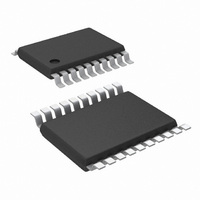LM20343MH/NOPB National Semiconductor, LM20343MH/NOPB Datasheet - Page 12

LM20343MH/NOPB
Manufacturer Part Number
LM20343MH/NOPB
Description
IC REG SYNC BUCK 3A 20TSSOP
Manufacturer
National Semiconductor
Series
PowerWise®r
Type
Step-Down (Buck)r
Datasheet
1.LM20343MHNOPB.pdf
(20 pages)
Specifications of LM20343MH/NOPB
Internal Switch(s)
Yes
Synchronous Rectifier
Yes
Number Of Outputs
1
Voltage - Output
0.8 ~ 32 V
Current - Output
3A
Frequency - Switching
250kHz, 750kHz
Voltage - Input
4.5 ~ 36 V
Operating Temperature
-40°C ~ 125°C
Mounting Type
Surface Mount
Package / Case
20-TSSOP Exposed Pad, 20-eTSSOP, 20-HTSSOP
Primary Input Voltage
36V
No. Of Outputs
1
Output Voltage
32V
Output Current
3A
No. Of Pins
20
Operating Temperature Range
-40°C To +125°C
Msl
MSL 1 - Unlimited
Filter Terminals
SMD
Rohs Compliant
Yes
For Use With
LM20343EVAL - EVALUATION BOARD FOR THE LM20343
Lead Free Status / RoHS Status
Lead free / RoHS Compliant
Power - Output
-
Other names
*LM20343MH
*LM20343MH/NOPB
LM20343MH
*LM20343MH/NOPB
LM20343MH
www.national.com
where, C
L (H) is the value of the inductor, V
voltage drop ignoring loop bandwidth considerations, ΔI
STEP
capacitor ESR, V
the set regulator output voltage. Both the tolerance and volt-
age coefficient of the capacitor should be examined when
designing for a specific output ripple or transient droop target.
INPUT CAPACITOR SELECTION
Good quality input capacitors are necessary to limit the ripple
voltage at the VIN pin while supplying most of the switch cur-
rent during the on-time. In general it is recommended to use
a ceramic capacitor for the input as they provide both a low
impedance and small footprint. One important note is to use
a good dielectric for the ceramic capacitor such as X5R or
X7R. These provide better over temperature performance
and also minimize the DC voltage derating that occurs on Y5V
capacitors. The input capacitors C
placed as close as possible to the VIN and GND pins on both
sides of the device.
Non-ceramic input capacitors should be selected for RMS
current rating and minimum ripple voltage. A good approxi-
mation for the required ripple current rating is given by the
relationship:
As indicated by the RMS ripple current equation, highest re-
quirement for RMS current rating occurs at 50% duty cycle.
For this case, the RMS ripple current rating of the input ca-
pacitor should be greater than half the output current. For best
performance, low ESR ceramic capacitors should be placed
in parallel with higher capacitance capacitors to provide the
best input filtering for the device.
SETTING THE OUTPUT VOLTAGE (R
The resistors R
voltage for the device. provides suggestions for R
R
If different output voltages are required, R
lected to be between 4.99 kΩ to 49.9 kΩ and R
calculated using the equation below.
ADJUSTING THE OPERATING FREQUENCY (R
The operating frequency of the LM20343 can be adjusted by
connecting a resistor from the RT pin to ground. The equation
FB2
(A) is the load step change, R
for common output voltages.
TABLE 1. Suggested Values for R
OUT
(F) is the minimum required output capacitance,
R
FB1
FB1
short
4.99
8.87
12.7
21.5
31.6
52.3
IN
(kΩ)
and R
(V) is the input voltage, and V
R
FB2
FB2
open
10.2
10.2
10.2
10.2
10
10
are selected to set the output
(kΩ)
IN1
DROOP
ESR
V
FB1
and C
0.8
1.2
1.5
1.8
2.5
3.3
5.0
OUT
FB1
, R
(Ω) is the output
FB2
(V) is the output
and R
FB2
IN2
should be se-
)
FB1
should be
RT
OUT
FB2
)
FB1
can be
(V) is
OUT-
and
12
shown below can be used to calculate the value of R
given operating frequency.
Where, f
frequency adjust resistor in kΩ. Please refer to the curve Os-
cillator Frequency versus R
acteristics section. If the R
not operate.
LOOP COMPENSATION (R
The purpose of loop compensation is to meet static and dy-
namic performance requirements while maintaining adequate
stability. Optimal loop compensation depends on the output
capacitor, inductor, load and the device itself. Table 2 below
gives values for the compensation network that will result in
a stable system when using a 150 µF, 6.3V POSCAP output
capacitor (6TPB150MAZB).
If the desired solution differs from the table above the loop
transfer function should be analyzed to optimize the loop
compensation. The overall loop transfer function is the prod-
uct of the power stage and the feedback network transfer
functions. For stability purposes, the objective is to have a
loop gain slope that is -20dB/decade from a very low frequen-
cy to beyond the crossover frequency. Figure 3 shows the
transfer functions for power stage, feedback/compensation
network, and the resulting compensated loop for the
LM20343.
TABLE 2. Recommended Compensation for
V
12
12
12
12
12
12
SW
5
5
5
5
5
IN
C
OUT
is the switching frequency in kHz, and R
= 150 µF, I
V
3.3
2.5
1.5
1.2
0.8
3.3
2.5
1.5
1.2
0.8
OUT
5
RT
L (µH)
OUT
RT
6.8
5.6
4.7
3.3
2.2
1.5
2.2
3.3
2.2
1.5
resistor is omitted the device will
C1
2
in the typical performance char-
, C
= 3A, f
C1
)
R
C
SW
43.2
43.2
48.7
30.1
23.2
43.2
30.1
30.1
30.1
34
34
(kΩ) C
= 500kHz
C1
4.7
3.3
2.2
2.2
2.2
3.3
3.3
2.2
3.3
2.2
1
(nF)
RT
RT
is the
for a










